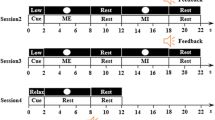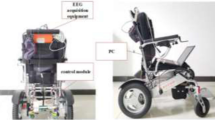Abstract
Multiple degrees of freedom (DOF) commands are required for a brain-actuated virtual automatic car, which makes the brain-computer interface (BCI) control strategy a big challenge. In order to solve the challenging issue, a mixed model of BCI combining P300 potentials and motor imagery had been realized in our previous study. However, compared with single model BCI, more training procedures are needed for the mixed model and more mental workload for users to bear. In the present study, we propose a multiple patterns of motor imagery (MPMI) BCI method, which is based on the traditional two patterns of motor imagery. Our motor imagery BCI approach had been extended to multiple patterns: right-hand motor imagery, left-hand motor imagery, foot motor imagery, and both hands motor imagery resulting in turning right, turning left, acceleration, and deceleration for a virtual automatic car control. Ten healthy subjects participated in online experiments, the experimental results not only show the efficiency of our proposed MPMI-BCI strategy but also indicate that those users can control the virtual automatic car spontaneously and efficiently without any other visual attention. Furthermore, the metric of path length optimality ratio (1.23) is very encouraging and the time optimality ratio (1.28) is especially remarkable.

The paradigm of multiple patterns of motor imagery detection and the relevant topographies of CSP weights for different MI patterns.






Similar content being viewed by others
References
Bromberg MB (2008) Quality of life in amyotrophic lateral sclerosis. Phys Med Rehab Clinics North Amer 19(3):591–605
Bin G, Gao X, Yan Z, Hong B, Gao S (2009) An online multi-channel SSVEP-based brain–computer interface using a canonical correlation analysis method. J Neural Eng 6:1–6
Panicker R, Puthusserypady S, Sun Y (2011) An asynchronous p300 BCI with SSVEP-based control state detection. IEEE Trans Biomed Eng 99:1781–1788
Fomina T, Lohmann G, Erb M, Ethofer T, Schölkopf B, Grosse-Wentrup M (2016) Self-regulation of brain rhythms in the precuneus: a novel BCI paradigm for patients with als. J Neural Eng 13(6):066021
Serrano JI, del Castillo M, Bayón C, Ramírez O, Lara SL, Martínez-Caballero I, Rocon E (2017) BCI-based facilitation of cortical activity associated to gait onset after single event multi-level surgery in cerebral palsy. In: Brain-Computer interface research. Springer, pp 99–110
LaFleur K, Cassady K, Doud A, Shades K, Rogin E, He B (2013) Quadcopter control in three-dimensional space using a noninvasive motor imagery-based brain–computer interface. J Neural Eng 10 (4):046003
Sirker A, Mamas M, Kwok CS, Kontopantelis E, Ludman P, Hildick-Smith D, Society BCI (2016) Outcomes from selective use of thrombectomy in patients undergoing primary percutaneous coronary intervention for st-segment elevation myocardial infarction: an analysis of the british cardiovascular intervention society/national institute for cardiovascular outcomes research (BCIs-nicor) registry, 2006–2013. J Am Coll Cardiol Intv 9(2):126–134
Wang H, Bezerianos A (2017) Brain-controlled wheelchair controlled by sustained and brief motor imagery BCIs. Electron Lett 53(17):1178–1180
Huang D, Qian K, Fei D-Y, Jia W, Chen X, Bai O (2012) Electroencephalography (eeg)-based brain–computer interface (BCI): a 2-d virtual wheelchair control based on event-related desynchronization/synchronization and state control. IEEE Trans Neural Syst Rehab Eng 20(3):379–388
Rebsamen B, Burdet E, Guan C, Zhang H, Teo C, Zeng Q, Ang M, Laugier C (2006) A brain-controlled wheelchair based on p300 and path guidance, in biomedical robotics and biomechatronics, 2006. BioRob. The First IEEE/RAS-EMBS International Conference on IEEE 2006:1101–1106
Diez PF, Müller SMT, Mut VA, Laciar E, Avila E, Bastos-Filho TF, Sarcinelli-Filho M (2013) Commanding a robotic wheelchair with a high-frequency steady-state visual evoked potential based brain–computer interface. Medical Engineering & Physics 35(8):1155–1164
Pfurtscheller G, Solis-Escalante T, Ortner R, Linortner P, Muller-Putz GR (2010) Self-paced operation of an ssvep-based orthosis with and without an imagery-based brain switch: a feasibility study towards a hybrid BCI. IEEE Trans Neural Syst Rehab Eng 18(4):409–414
Allison BZ, Brunner C, Kaiser V, Muller-Putz GR, Neuper C, Pfurtscheller G (2010) Toward a hybrid brain-computer interface based on imagined movement and visual attention. J Neural Eng 7(2):26007
Long J, Li Y, Wang H, Yu T, Pan J, Li F (2012) A hybrid brain computer interface to control the direction and speed of a simulated or real wheelchair. IEEE Trans Neural Syst Rehab Eng 20(4):720–729
Wang H, Li Y, Long J, Yu T, Gu Z (2014) An asynchronous wheelchair control by hybrid EEG-EOG brain-computer interface. Cogn Neurodyn 8(5):399–409
Hart SG, Staveland LE (1988) Development of nasa-tlx (task load index): results of empirical and theoretical research. Adv Psychol 52:139–183
Mugler EM, Ruf CA, Halder S, Bensch M, Kubler A (2010) Design and implementation of a p300-based brain-computer interface for controlling an internet browser. IEEE Trans Neural Syst Rehabil Eng 18(6):599–609
Riccio A, Leotta F, Bianchi L, Aloise F, Zickler C, Hoogerwerf EJ, Kubler A, Mattia D, Cincotti F (2011) Workload measurement in a communication application operated through a p300-based brain-computer interface. J Neural Eng 8(2):025028
Homan RW, Herman J, Purdy P (1987) Cerebral location of international 10–20 system electrode placement. Electroencephalograph Clin Neurophysiol 66(4):376–382
Ludwig KA, Miriani RM, Langhals NB, Joseph MD, Anderson DJ, Kipke DR (2009) Using a common average reference to improve cortical neuron recordings from microelectrode arrays. J Neurophysiol 101(3):1679–1689
Dornhege G, Blankertz B, Curio G, Muller KR (2004) Boosting bit rates in noninvasive eeg single-trial classifications by feature combination and multiclass paradigms. IEEE Trans Biomed Eng 51(6):993–1002
Li M, Lin L, Jia S Multi-class imagery eeg recognition based on adaptive subject-based feature extraction and svm-bp classifier. In: Mechatronics and automation (ICMA) 2011 international conference on IEEE 2011, pp 1184–1189
Lotte F, Guan C (2011) Regularizing common spatial patterns to improve BCI designs: unified theory and new algorithms. IEEE Trans Biomed Eng 58(2):355–62
Dong E, Li C, Li L, Du S, Belkacem AN, Chen C (2017) Classification of multi-class motor imagery with a novel hierarchical svm algorithm for brain–computer interfaces. Med Biolog Eng Comput, 1–10
Blankertz B, Tomioka R, Lemm S, Kawanabe M, Müller K-R (2008) Optimizing spatial filters for robust EEG single-trial analysis. IEEE Signal Process Mag 25(1):41–56
Chen S-G, Wu X-J (2017) Multiple birth least squares support vector machine for multi-class classification. Int J Mach Learn Cybern 8(6):1731–1742
Chang C-C, Lin C-J (2011) Libsvm: a library for support vector machines. ACM Trans Intell Syst Technol (TIST) 2(3): 27
Zhang Y, Liu B, Ji X, Huang D (2017) Classification of eeg signals based on autoregressive model and wavelet packet decomposition. Neural Process Lett 45(2):365–378
Joachims T (1998) Making large-scale svm learning practical, Technical Report, SFB 475: Komplexitätsreduktion in Multivariaten Datenstrukturen. Tech. Rep., Universität Dortmund
Allwein EL, Schapire RE, Singer Y (2001) Reducing multiclass to binary: a unifying approach for margin classifiers. J Mach Learn Res 1:113–141
Iturrate I, Antelis JM, Kubler A, Minguez J (2009) A noninvasive brain-actuated wheelchair based on a p300 neurophysiological protocol and automated navigation. IEEE Trans Robot 25(3):614–627
Pfurtscheller G, Brunner C, Schlögl A, Da Silva FL (2006) Mu rhythm (de) synchronization and eeg single-trial classification of different motor imagery tasks. Neuroimage 31(1):153–159
Funding
This study was supported by the Technology Development Project of Guangdong Province (No. 2017A010101034), Innovation Projects for Science supported by Department of Education of Guangdong Province (No. 2016KTSCX141), Science Foundation for Young Teachers of Wuyi University (No. 2018td01).
Author information
Authors and Affiliations
Corresponding author
Rights and permissions
About this article
Cite this article
Wang, H., Li, T., Bezerianos, A. et al. The control of a virtual automatic car based on multiple patterns of motor imagery BCI. Med Biol Eng Comput 57, 299–309 (2019). https://doi.org/10.1007/s11517-018-1883-3
Received:
Accepted:
Published:
Issue Date:
DOI: https://doi.org/10.1007/s11517-018-1883-3




